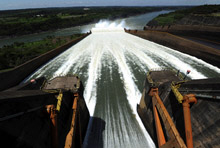
Typical street scene in Santa Ana, El Salvador. (Photo: iStock)
IMF Survey: Emerging Markets Tackle Risks, Cement Global Power
April 18, 2011
- Rise in emerging market economic power to extend beyond crisis
- New risks, possible overheating threat to leadership if not addressed
- Structural reforms will help rebalancing and more productive investments
Emerging market countries are set to strengthen their standing in the world economy, but they must take steps to manage the risks that come with shifting global economic power, said panelists at an International Monetary Fund (IMF)–sponsored seminar in Washington DC.

Itaipu Dam in Brazil. Despite natural, geopolitical crises money flowed into emerging markets, against some expectations (photo: Joedson Alves/DPA)
IMF-WORLD BANK SPRING MEETINGS
Their “extraordinary” performance stands in stark contrast to the high debt and sluggish growth in advanced countries, said moderator Lin Xue Ling of Channel NewsAsia, opening the session. But possible overheating is now a worry for emerging economies, she added.
The IMF’s latest global forecasts project emerging economies will grow by 6½ percent this year (and an even higher 8 percent in emerging Asia) compared with expected global growth of 4½ percent, said panelist and IMF Deputy Managing Director Naoyuki Shinohara.
The April 13 event—“Emerging Markets: Leading the Recovery, but What Next?”—was one of two major seminars held during the IMF-World Bank Spring Meetings.
Growth decoupling
The divergent growth prospects of emerging and advanced economies are here to stay, according to Domenico Lombardi, senior fellow at the Brookings Institution.
Panelists regarded this “decoupling” of growth as a good thing—it “saved the day during the financial crisis,” said Moisés Naím, senior associate at the Carnegie Endowment for International Peace.
This does not discount the need for economic rebalancing, Lombardi said. Still weak growth, and the need to reduce government debts and deficits in advanced economies, means that emerging economies will have to rely more on domestic sources of growth.
Nor does the decoupling of growth reflect cyclical differences between emerging and advanced economies, argued Lombardi. Increasing south-south flows—that is, increased trade and financial flows among emerging and developing countries—will help make up for the falloff in demand from advanced economies.
Emerging markets demonstrated the durability of their economic success in the face of recent shocks—the Japanese earthquake and tsunami, and unrest in the Middle East—agreed Joyce Chang, Managing Director and Head of Emerging Markets and Global Credit Research at JPMorgan, and Sebastian Mallaby, Senior Fellow at the Council on Foreign Relations.
In the face of these events, money had flowed into emerging markets, contrary to what we might have expected. There had been a flight to quality, Mallaby said.
So “can we now all go back home and sleep well because we know emerging markets are … going to pull all the rest of the world out of the trouble we’re in?” asked Ling.
Threat to success?
“Complacency is always a problem,” warned Shinohara, echoing comments from IMF Managing Director Dominique Strauss-Kahn earlier that day.
Emerging economies are facing mounting risks. Overheating and inflationary pressures are the most pressing issues, with strong domestic demand, output levels that are close to their potential, and high capital inflows.
Other panelists agreed on the importance of managing risks. “We all know that the engine of dynamism is out there in the emerging world, but the projected growth gap is coming down and the risks are probably bigger,” said Mallaby.
“If this conversation would have happened a year ago, it would have centered on deflationary risks, whereas now we’re all worried about inflation,” said Naím.
The main sources of inflationary pressure are narrowing output gaps, rising commodity prices, and a wave of capital inflows, according to panelists. Shinohara also suggested that the “too slow” pace of monetary policy tightening for most emerging economies reflects worries about the impact on capital flows.
Capital controls here to stay
The need for countries to manage large capital inflows, possibly for an extended time, prompted a lively debate about the merits of capital controls. “Capital controls here to stay. It’s just a reality,” noted Chang.
Reflecting recently announced IMF research on country experiences with capital controls, Shinohara confirmed that the IMF now views capital controls as part of the toolkit of economic policies. “The IMF has really moved forward on this,” Lombardi said.
However, Mallaby took a contrary view, worrying that a “free for all” on the use of capital controls could result in more “currency wars” and expressing some skepticism over their longer-term effectiveness.
Chang countered that “even if they don’t work longer term, they work politically short term for a lot of policymakers who are trying to manage a number of different constituencies—exporters—and are very worried about the level of the exchange rate.” In doing so, they provide breathing space for policymakers to use other policy measures.
Naím cautioned that the wide range of both country circumstances and measures that could be considered capital controls made this issue hard to talk about this in general terms.
He expressed main concerns that might impede the appropriate use of controls. First, “which country and which public sector” is important—not all governments have sufficient technical capacity to effectively implement controls.
Making investment work
There is also a “danger that … by implementing something called capital controls, you distract or find an excuse for not doing the hard work,” added Naím. Shinohara agreed, stressing that capital controls are no substitute for the right macroeconomic policies and structural reform.
Despite the challenges posed by capital inflows, Chang pointed to the positive. “The global imbalance story … is not just about interest rate policy, it’s the first time that developed country investors are truly focused on global diversification,” she said.
She also thought it particularly important that policymakers in emerging markets are thinking about how to make investment flows work best for them, focusing on reforms that will “attract capital flows into areas where we really need them, like infrastructure development.”







